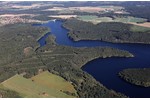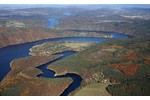Reservoirs as chronicles of socio-economical changes in their catchment
In the 20th century, numerous reservoirs were built on the river network in the Czech Republic. Freshwater reservoirs are water bodies of special interest, as they provide various ecosystem services such as the supply of drinking water, agricultural irrigation, industrial and cooling water supplies, power generation, flood control and recreation. During their history, reservoirs have undergone significant environmental changes that can be identified by long-term datasets. The Institute of Hydrobiology has conducted long-term monitoring of the Slapy and Římov Reservoirs since 1959 and 1979, respectively. Long-term trends of environmental conditions in the reservoirs have been recently published in several scientific journals.
We demonstrated that reservoir ecosystems integrate cumulative terrestrial influences and socioeconomic changes in the catchment, which can be exemplified by the long-term trend in ionic, especially nitrate concentrations. During the era of the planned economy, which lasted from around 1948 until 1989, lake-water nitrate concentrations increased due to an excessive use of synthetic fertilisers, draining of agricultural land, and poor environmental protection. After 1989, dramatic decreases in the application of synthetic fertilisers and atmospheric pollution, an end to soil drainage, rapidly decreasing livestock numbers, and partial conversion of arable land to extensive grassland caused an abrupt decrease in nitrate concentrations in both reservoirs. Physico-chemical properties of lake water also exhibit changes related to climate change. The epilimnetic water temperature has been continuously increasing since the 1990s. The associated changes in thermal stratification have been shown to affect in-lake phosphorus cycling, resulting in increasing water eutrophication in the Slapy Reservoir.
More details on individual trends in environmental conditions in both reservoirs can be found in following papers.
Kopáček J., Hejzlar J., Porcal P., Posch M., 2017. Trends in riverine element fluxes: A chronicle of regional socio-economic changes. Water Res. 125, 374–383.
Vystavna Y., Hejzlar J., Kopáček J., 2017. Long-term trends of phosphorus concentrations in an artificial lake: Socio-economic and climate drivers. PloS ONE 12 (10): e0186917, DOI:10.1371/journal.pone.0186917.
Znachor P., Nedoma J., Hejzlar J., Seďa J., Kopáček J., Boukal D., Mrkvička T., 2018. Multiple long-term trends and trend reversals dominate environmental conditions in a man-made freshwater reservoir. Sci. Total Environ. 624: 24–33. DOI: 10.1016/j.scitotenv.2017.12.061














